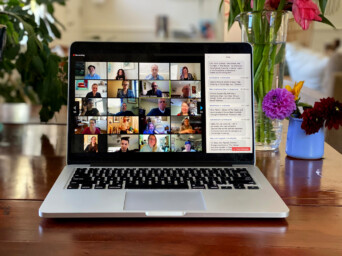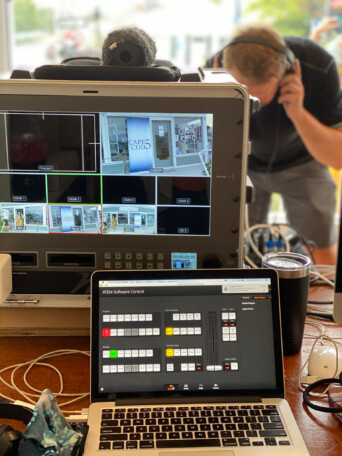Small Business Advocacy Monopoly power in the local broadband market leaves Cape Codders disconnected
Corporate control over broadband service leaves millions of Americans paying way too much for poor connection and poor service, including Cape Codders. Without reliable, accessible and affordable modern technology, communities like ours will surely be left behind.

- Post Date
- Tue, Sep 7
- Small Business Advocacy
It was never more apparent that high-speed internet access is an essential public infrastructure than throughout the COVID-19 pandemic when much of our civic, economic, and personal lives shifted online. But corporate control over broadband service leaves millions of Americans across the country paying way too much for poor connection and poor service. There is perhaps no more a glaringly obvious example of monopoly power on Cape Cod than the region’s internet service, which impacts the daily lives and pocketbooks of residents, as well as the operations and bottom lines of small businesses.
The evolution of internet connection from the dial-up service of the early days to one that enables people to be connected constantly (the most common being cable modems, provided by cable television companies and DSL, provided by telephone companies) enables people access to many essential services like employment, education, and health care, as well as links businesses to additional customers and connects family and friends regardless of how far away they live. At this point the internet is as essential as electricity.

Yet the private sector has failed to deliver universal broadband connectivity. While large internet service providers (ISPs) are responsible for connecting much of the nation, their ultimate objective is to monopolize the markets through unchecked power and growth.
A report by the advocacy organization Common Cause breaks down this reality stating “most Americans have no meaningful choice when it comes to high-speed broadband. Without robust competition and public oversight, broadband providers have no incentive to upgrade their networks while increasing the prices they charge. Further, large providers have failed to invest in unprofitable areas, leaving parts of rural America unconnected and redlining low-income neighborhoods in urban areas with substandard service.” Nearly 50 percent of Americans lack reliable access to the internet.
In the early days of the world wide web you would see thousands of ISPs competing with each other for customers –as late as 1998 there were still 4,500 providers in the market – today, two cable companies, Comcast-Xfinity and Charter-Spectrum, control more than half of the broadband market, enabling poor service and dated broadband infrastructure, while trapping customers in a high-priced situation for which there is no alternative.
Having poor internet connection doesn’t just cause individual frustrations and inconvenience when a Zoom call is dropped or you can’t binge Netflix. Not having fast, affordable and reliable internet has a community-wide impact. Studies continue to show that access to high-quality broadband boosts property values and contributes to economic vitality. According to Sean Gonsalves, senior reporter, editor, and researcher for the Institute for Local Self Reliance Community Broadband Networks Initiative (and Cape Codder), research has shown that “communities that have fiber, they have a much more robust economy.” He explained that “broadband impacts real estate, business, civic engagement, telehealth, economic development, schools, and government operating costs…it creates more resilient communities.” This will influence both businesses and residents on where they want to live and work – “efficiency, speed and reliability – internet connectivity can be the decider.”
However, it’s important to note that even in areas that are served by broadband networks, without competition, consumers are threatened with artificially high prices, lower-quality service, and little innovation.

Simply put, Cape Cod is one of those communities at risk.
Essentially, Cape Cod has one internet provider – 99% of internet customers on the Cape are served by Comcast. This means they can get away with not upgrading their outdated infrastructure (they operate on a cable based broadband internet, whereas fiber optic networks are a more modern technology with greater speed and reliability), providing inferior service, and charging their local customers some of the highest prices in the country. Bottom line: the Cape’s internet service is slow, unreliable, and expensive.
“The level of service [Comcast] provides is O.K., but the price you pay is high and the quality of the internet is low – their download and upload speeds vary greatly – compared to just over the bridge where there’s more competition,” explained Bert Jackson CEO of the Cape Cod Technology Council. In addition, “they don’t cover all areas of the Cape and upgrading their infrastructure is not worth their while.”
According to a study done by CCG Consulting for FalmouthNet, a community broadband advocacy group out of Falmouth, broadband customers “experience inconsistent speeds and frequent outages,” and “the Comcast network is not delivering the speeds that customers are paying for.” Good download speeds are needed for viewing your social media feed, streaming music, and reading news articles and shared documents, whereas good upload speeds are needed for connecting to a school server, sending files, gaming, and for connecting to online video meetings. They purport that “the most likely reason for the slow speeds is that the Comcast network configuration has not been modernized…the infrastructure is outdated, with no competition driving future upgrades.”
Comcast operates the Cape’s internet on a system built by Adelphia Communications Corporation almost three decades ago. “Comcast has no incentive to invest in old networks,” said Gonsalves, “they know everyone needs it.”
So, not only does lack of competition lead to much higher prices consumers have no choice but to pay, but it also means in regions like Cape Cod with one dominant internet service provider the monopolist will make minimal effort to provide their customers with the technology necessary to operate in the modern world.
The market wasn’t always this way. During the dial-up era, ISP start-ups simply needed a bunch of modems to connect their customers through telephone lines. The result was that nearly every home in the United States was connected to the internet. But according to Gonsalves and his colleague Christopher Mitchell in a piece they wrote for the American Prospect, “as technology advanced, the big telephone companies no longer had to share advanced parts of their networks, ensuring that small ISPs could not offer faster speeds without massive capital investments that were largely beyond their capacity.”
The passage of the Telecommunications Act of 1996 complicated things for consumers and would-be ISPs by allowing fewer, but larger corporations, to operate more media enterprises within a sector and to expand across media sectors, thus enabling massive and historic consolidation of media in the United States. “Within ten years of the passage of the Telecommunications Act of 1996, most Americans were left having to choose between DSL from the telephone company or cable modem service from the one cable company in their area,” Gonsalves and Mitchell wrote, “cable monopolies were eventually able to get the most broadband subscribers, because the cost of upgrading copper telephone lines was too great for phone companies to remain competitive.”
Presently, the high up-front capital costs make entering this market nearly impossible. What’s more, corporations exercise their political influence when communities try to come together to come up with solutions to the problems associated with concentration in broadband. According to the Common Cause report, in the 116th Congress alone, these corporations spent $234 million on lobbying and federal elections – an average of more than $320,000 a day (Comcast was the biggest spender at more than $43 million), “to pass legislation they like and block legislation they don’t like, all to grow their present and future profits regardless of the impact on everyday Americans.”

In spite of Comcast’s efforts to discourage community efforts to build local broadband networks as a source of competition through lobbying at the state level, more than 550 communities across the country have built their own fiber networks.
According to Gonsalves, the fiber infrastructure in community broadband networks is built through long-term financing options and bonds available to municipalities. They then choose whether they want to run the system themselves like an enterprise fund, run it through cooperatives or using a public-private partnership (for example, the network in Chattanooga, TN is run by the electric company).
The idea with community broadband is that “there is no profit motive; it is not set up to be a money-making venture.” Community broadband networks don’t engage in predatory behavior like setting data caps and charging hidden fees, and many have done away with things like installation fees all together.
“The people that run the networks are community members,” Gonsalves explained, “and they are keeping the money [paid by customers] in the community.” What’s more, fiber broadband is far superior to DSL and cable broadband. “It’s like getting a Tesla and paying for a Pinto.” He went on to say that “it’s about starting a conversation in a community about the power they have to finally compete with Comcast.”
One such conversation began happening in Falmouth when a group residents began looking at community networks after an internet outage in parts of Falmouth lasted for five days in 2018. FalmouthNet aims to build a Falmouth-wide, all fiber network using all 460 miles of Falmouth’s roads and serve Falmouth’s 24,000 homes and businesses. The recent feasibility study by CCG Consulting showed a new fiber network would eliminate slowdowns and interruptions and could accommodate future growth. The estimated projected cost is about $55 million, but with sixty-one percent of the served community expressing interest in signing with an alternative to Comcast, CCG determined that it would be financially feasible to execute.
These types of community broadband networks are possible up and down Cape Cod because the region already has a middle-mile fiber optic network owned and operated by local nonprofit, OpenCape. The network that went live in 2013 and was financed through government funding and grants and as Jackson puts it, “is the Route 6 of the internet on Cape Cod.” Its network serves local governments, businesses, and anchor institutions such as libraries, schools, hospitals, and scientific laboratories. What OpenCape doesn’t do is bring the fiber to the “last mile,” which would connect residential and small business communities.
Connecting the last mile of fiber broadband for Cape Codders and across the country requires a policy environment at the federal, state, and local that encourages competition and the development of community networks. The market in its current condition leaves tens of millions of families and businesses without any recourse from awful service. Government at every level can intervene to create competition and spur innovation to ensure people and businesses have the services they rely on. The federal government plays a key role in assisting municipalities with financing options such as subsidies, one-time grants, or loans. Congress, the Department of Justice and the FCC also have the ability to keep these corporations in check through anti-trust action and enforcement, as well as by limiting their level of influence in government through campaign finance reform and more transparency in lobbying.

State legislatures can create a supportive environment for community broadband networks by removing any laws that might discourage their formation or favor large providers like right of first refusal laws giving them the opportunity to veto potential competition, ensuring that local governments have the authority to issue bonds for broadband projects, offering programs that help them access the capital markets, or giving grants to help determine feasibility and planning of local projects.
At the local level Gonsalves hopes to see municipal and regional entities fostering and supporting conversations around community broadband networks, as well as instating a “dig once policy” where conduits for fiber networks are laid during construction projects happening now to prepare the community for the technology and save on costs for future projects.
Finally, every level of government should gather data on the present level of service being provided to their constituents, including network speeds and price points. And then when community broadband networks are in place, use their power of procurement to support them by purchasing their service, keeping important taxpayer dollars in the local community.
Broadband connections have been responsible for a significant portion of American economic progress in this century, and high-performance broadband will help grow the American economy in the next decade.
Without reliable, accessible and affordable modern technology, communities like Cape Cod will surely be left behind.
This article (which has been updated in 2023) was part of a year-long investigative series performed by Amanda Converse in 2021 that explored how corporate concentration has affected various industries across the country and what impact that can and does have on Cape Cod’s local economy. The work was supported by the 2021 Mission Supporters: Cape Cod 5, Nauset Disposal, Mid-Cape Home Center, and Duffy Health Center.
Related articles
- Post Date
- Sat, Aug 31
- Small Business Advocacy
- Post Date
- Wed, Aug 21
- Small Business Advocacy

